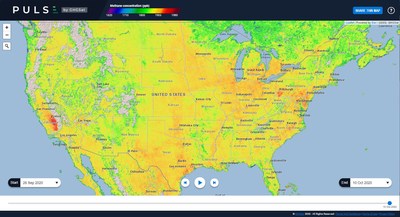Pulse shows monthly methane concentrations averages, updated weekly, on a grid averaging 2km x 2km over land. A slider function lets users explore how gas levels change over time, with the facility to track back, up to six months.
The new map is intended to raise awareness of, and support discussion about, this potent greenhouse gas by showing spatial and temporal patterns of methane, around the world. For example, the map shows how concentrations of CH4 grow in Greenland, Finland and Russia during the Arctic summer; how the Dolomite Mountains traps the gas in Italy's Po Valley and how levels remain consistently high throughout the year over the Permian Basin, the epicenter of US oil and gas production.
Carbon dioxide's role in climate change is well documented but methane has, until recently, escaped the same scrutiny. Concentrations of CH4 in the atmosphere are increasing. Invisible to the naked eye, it has a global warming potential around 84 times greater than CO2, over 20 years, and accounts for about a quarter of all man-made global warming.
This new resource shows concentrations that result from both the emission (release) and transport (movement in the atmosphere due to winds and chemical processes) of methane. Methane is produced by natural processes, such as the decay of vegetation in wetlands but a significant proportion (c. 60%) is attributable to human activity, with energy production, agriculture and waste management (landfills and dumpsites) all being major sources.
Pulse is not designed to identify specific methane emitters. However, to support industry and governments to reduce emissions, GHGSat offers a range of commercial services including hotspot detection, predictive analysis and 25m resolution imagery to identify sources.
GHGSat announced the map at the World Economic Forum (WEF) Annual Meeting in Davos in January 2020, where GHGSat was invited to participate as a WEF Technology Pioneer. The map was promised as a contribution to COP26 discussions, an opportunity for GHGSat to share its greenhouse gas expertise and data for free to help tackle climate change.
Stephane Germain, CEO, GHGSat said "Pulse represents the new state of the art when it comes to visualizing methane. Our day job is to monitor emissions for industry and governments around the world, using a growing fleet of satellite and aircraft sensors, and supported by powerful, proprietary analytics. We have drawn on all these capabilities in the design of Pulse, which will become an ever more important resource for all.
"This first iteration of Pulse is only the beginning. We are already pushing ahead with an advanced version that will map, not just concentrations, but also emissions - globally, on the same grid and with an even higher frequency. This matters because concentrations tell us how much gas there already is in the atmosphere: emissions reveal the rate at which methane is being added. Knowing this allows for the continuous quantification of gas emissions inventories, at any geographic scale (local, province, state or national)."
The interactive map is one of several initiatives by GHGSat to make data openly available. The company recently announced that 5% of its data from its second satellite, GHGSat-C1 "Iris" is being made available to the scientific community through an 'Announcement of Opportunity' with the European Space Agency (ESA) and the Canadian Space Agency. GHGSat data is also being assessed for inclusion in the ESA Third Party Mission programme which sponsors the cost of access to satellite data for research and earth observation purposes, enabling the scientific community to develop applications.
For further information and imagery please contact:
Canada and USA
Leidy Ojeda
+ 1 514 707-3806
Leidy.ojeda@franc-parler.ca
Europe
Richard Knight
+ 44 7725 996625
richard.knight@mettlepr.com
![]() View original content to download multimedia:
http://www.prnewswire.com/news-releases/ghgsat-launches-pulse---a-free-and-unique-high-resolution-methane-map-301157039.html
View original content to download multimedia:
http://www.prnewswire.com/news-releases/ghgsat-launches-pulse---a-free-and-unique-high-resolution-methane-map-301157039.html
SOURCE GHGSat
| Contact: |
| Company Name: GHGSat
Web: www.ghgsat.com |










